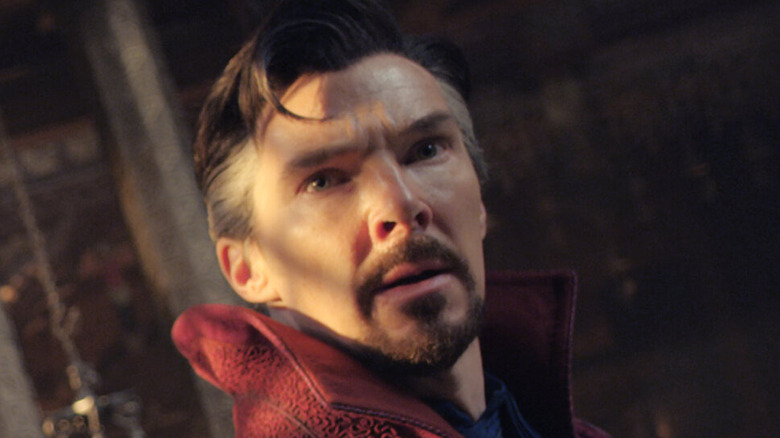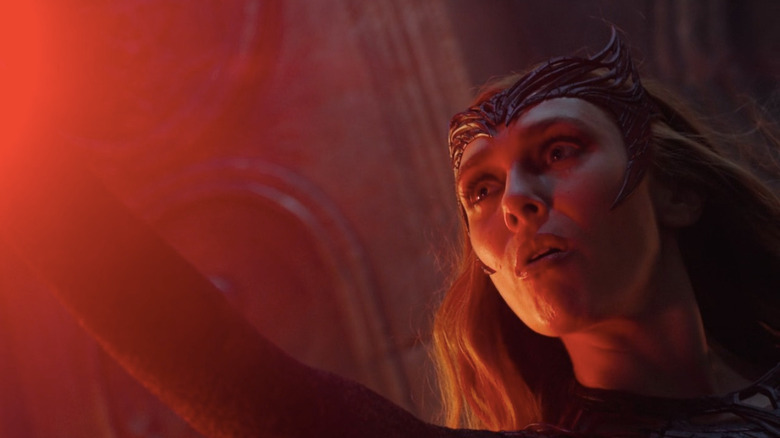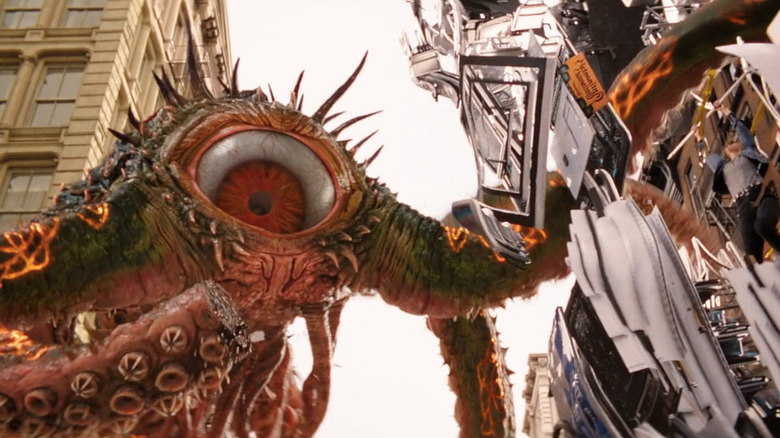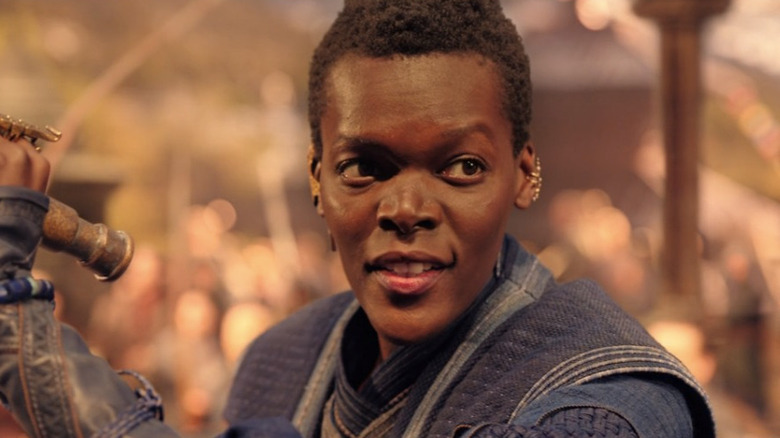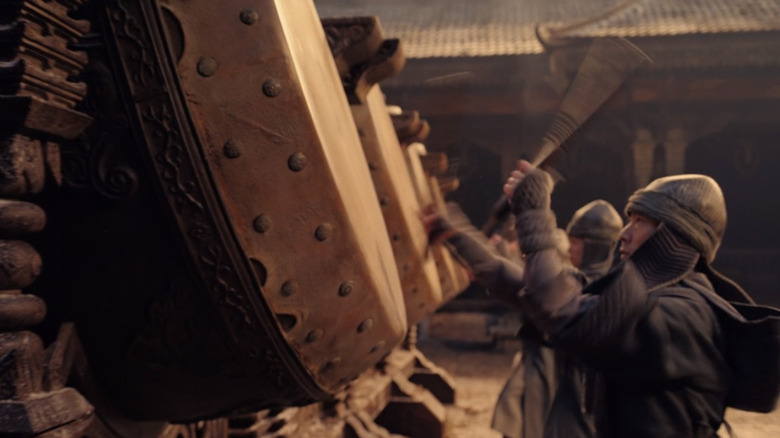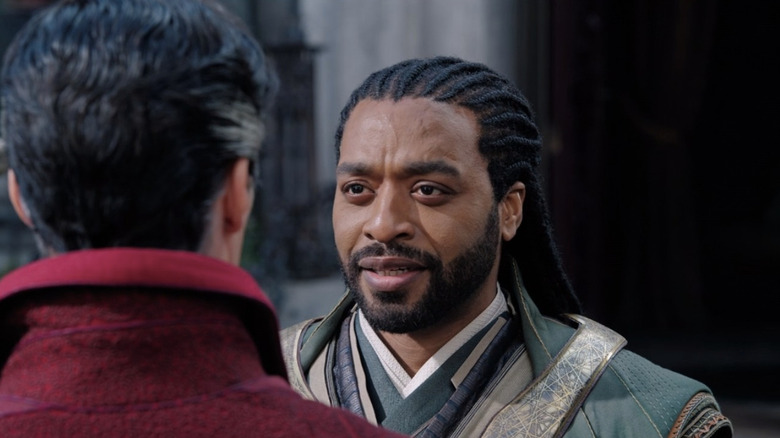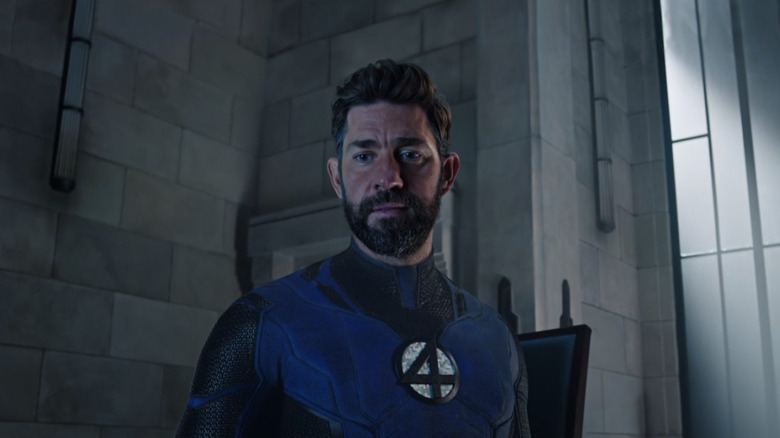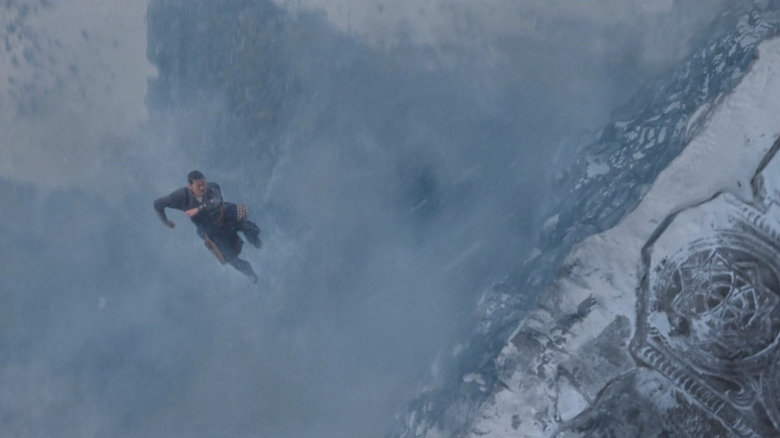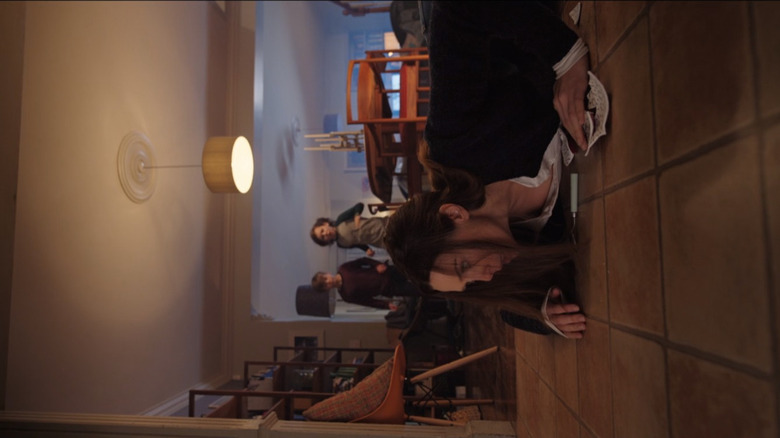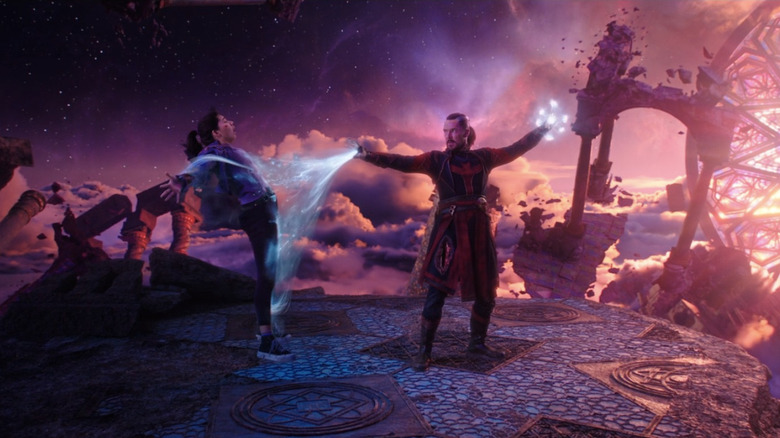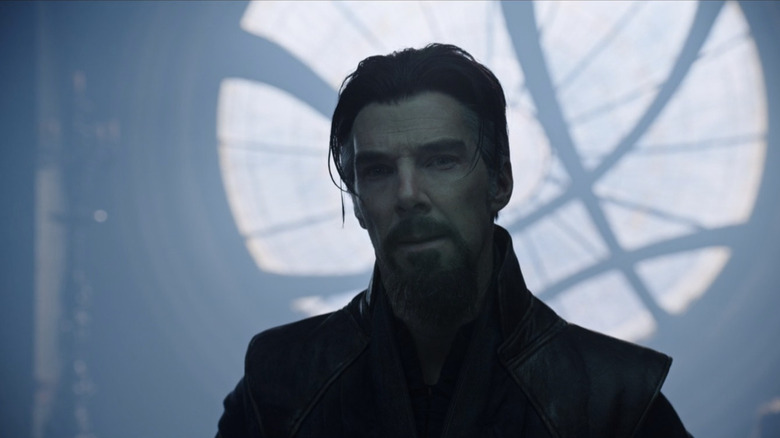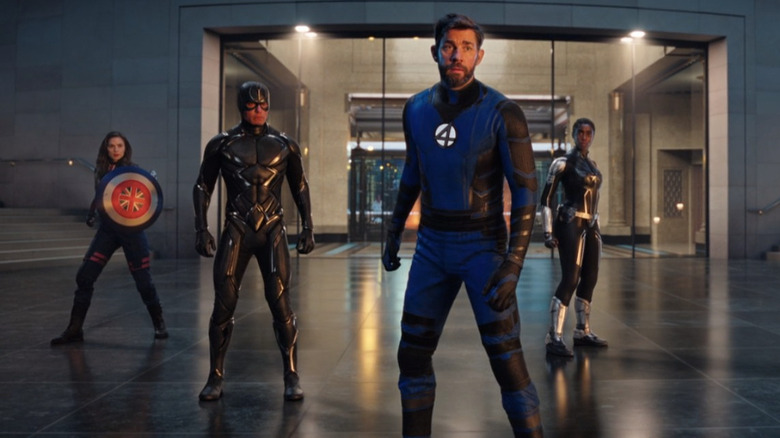Doctor Strange In The Multiverse Of Madness: The Wildest Things We Learned From The Audio Commentary
We may receive a commission on purchases made from links.
The below post contains spoilers for Marvel Studios' "Doctor Strange in the Multiverse of Madness."
As any cinephile knows, movie studios in the 2000s and 2010s didn't skimp on investing in behind-the-scenes bonus features for Blu-ray and DVD releases of most films. While physical media is far from obsolete, in today's streaming era, fewer disc releases hit store shelves — limiting the bonus material available for fans. Perhaps one of the most prudent casualties in this industry change is the decline of audio commentary. It's hard not to miss the company of filmmakers watching the movie with you and revealing fascinating backstage stories.
Despite the downward trend of physical media, Marvel rolled out a full commentary track for "Doctor Strange in the Multiverse of Madness" for its home video debut. The bonus feature is an incredible listen, included on the digital, Blu-ray, and 4K Ultra HD releases of the film. Currently, Disney+ subscribers can also find it in the movie's "Extras" tab. Hosted by director Sam Raimi, writer Michael Waldon, and producer Richie Palmer, the commentary track gives fans some amazing tidbits that probably go unnoticed by those unaware of the track's existence. Here are some of our favorite discoveries and insights into how the creative team crafted "Doctor Strange in the Multiverse of Madness."
Wanda's turn to villainy was almost saved for another movie
Many fans were surprised to discover that Wanda Maximoff (Elizabeth Olsen) is the villain in the MCU film. This reveal comes around 25 minutes into the movie, but initially, it arrived much later. In the audio commentary, Raimi revealed that in the first draft of the script, Wanda was "a good person, uncorrupted, throughout the entire adventure." Her turn to the "dark side" was saved until the "last scenes of the film." When COVID-19 delayed the film's production schedule, Waldron reconsidered Wanda's arc, asking, "If we wanted to blow this thing up and start over, what would we do?"
Raimi asked, "Why should we let the greatest moment of the movie set up and be the ending and really just open the door for the next one?" In postulating how Doctor Strange (Benedict Cumberbatch) and the Scarlet Witch arguably tie for Marvel's most powerful superhero, this change meant audiences could "see that delicious battle between Strange and Wanda throughout the meat of our film."
As vital a focal point as Wanda's turn is in "Multiverse of Madness," it's pretty wild to imagine saving Wanda's turn to dark magic for a future MCU movie. Based on the studio's calendar of upcoming projects, it's fun guessing which film Marvel initially wanted Scarlet Witch to play the antagonist.
Gargantos has Elizabeth Olsen's eye
Early in the film, Gargantos, a giant monster resembling a sea creature, attacks America Chavez (Xochitl Gomez) as she jumps into Doctor Strange's universe on the streets of New York City. Scarlet Witch sent Gargantos after America to gain possession of America's power to travel across the multiverse. At this point in the movie, though, the audience doesn't know Scarlet Witch is the mastermind behind the attacks. On the contrary, the character hasn't even appeared yet in the movie. But it turns out there's a hint of Wanda's plan staring the audience in the eye.
Producer Richie Palmer revealed this on the film's commentary track. "We actually took Lizzie Olsen's eyeball scan and made this eyeball, modeled after Lizzie Olsen's eye as a little foreshadowing for the real villain in the movie," he said. It takes the phrase "you have your mother's eyes" to a whole new level.
Wong and Sara were a romantic item
Sheila Atim plays Sara Wolfe, a new character in "Multiverse of Madness" and a Master of the Mystic Arts. Her role in the film is supportive and significant. Early on, the audience sees Sara protect Kamar-Taj from Wanda's attack. Later, Sara dies when she destroys the Darkhold to prevent Wanda from accessing its dark magic. As Sara perishes, she and Wong (Benedict Wong) share a glance, and she reaches for him.
However, there was initially much more exposition between these characters, making their last moment together more meaningful than it appears in the finished cut of the movie. In the film's commentary, Raimi called Sara "Wong's right-hand woman," and shared, "We have a little bit of a love line between Wong and Sara." This choice paralleled the characters' comic book history. But the thread became "diminished." Raimi explained why their relationship got cut, adding, "We just wanted to focus on our main heroes, and the story took a little too many dimensions. We had to focus it down, so that little bit of a suggested love story was lost."
Danny Elfman sent battle drums to set
Composer Danny Elfman is legendary. He's collaborated with director Sam Raimi on several projects, including Raimi's "Spider-Man" trilogy in the 2000s. Of course, he was a natural choice to score "Multiverse of Madness." Fittingly, Elfman also contributed music for 2015's "Avengers: Age of Ultron," Wanda's first big appearance in the MCU.
Elfman being attached to "Multiverse of Madness" early on in the filmmaking process allowed him to be more involved — beyond scoring the film's music in post-production. Producer Richie Palmer noted in the audio commentary that Elfman helped add gravitas to the day the crew filmed Wanda's attack on the Kamar-Taj sanctum. "Before he was really scoring the movie, he gave us war drums that we could play on set," Palmer said. "We [could] really amp the energy and know the cadence of those drums as we're going into this battle. It was really exciting. It added something to the day." Count on Danny Elfman to go the extra mile beyond his job description to make a movie better!
Wanda was supposed to behead 616 Mordo and crush the Wasp
Chiwetel Ejiofor reprises his role in "Multiverse of Madness" as Mordo, an adversary from 2016's "Doctor Strange" film. But this time, Ejiofor portrays an alternate version of the character in Earth-838. Here, Mordo is Sorcerer Supreme and a member of an Avengers-like group of superheroes called the Illuminati. In the "Multiverse of Madness," this is the only version of Mordo that we see. We never return to his counterpart from Earth-616. But that wasn't always the case!
In the film's audio commentary, Raimi shared that in one of Waldron's early drafts, 616-Mordo would have returned, having fought several battles since we last saw him. "He had a limp, and he was coming after the Scarlet Witch to take her power because he knew she was dark and terribly corrupted by the Darkhold," Raimi explained. "She killed him and cut off his head and presented it to Strange in a later scene. It was really great writing, but it slowed the beginning down too much, so we had to lose it."
Another multiverse hero was in early talks to be part of the Illuminati but didn't make the final roster. Waldron shared that in an earlier draft of the movie, "The Wasp shrunk down and flew at Wanda. She just clapped her hands and smushed the Wasp."
Reed Richards' casting was powered by fans
Marvel's first family, the Fantastic Four, have had their share of film adaptations over the years. However, none of them are in the MCU canon. When word got out that Marvel Studios would finally create a "Fantastic 4" movie, fan-cast conversations dominated online discussion about who fans thought should play Reed Richards, a.k.a. Mr. Fantastic. One of the top choices? John Krasinski! In assembling the roster for the Illuminati in "Multiverse of Madness," filmmakers had their pick of alternate versions of new and existing characters from across the multiverse. The film's flexibility led to one of the movie's best surprises.
Raimi discussed how Krasinksi's involvement went from dream to reality. "It's so funny that [Marvel Studios President] Kevin [Feige] cast John because the fans had a dream of who the perfect Reed Richards would be," he said. "Because it's an alternate universe, I think, Kevin said, 'Let's make that dream come true.'" Certainly, it was a fun shock to see Krasinski, and his appearance is made even more thrilling to know that it legitimately wouldn't have happened without the fans. Still, it remains to be seen whether Krasinki will play Richards in 2025's "Fantastic 4" film.
Sam Raimi pranked Benedict Wong
Midway through the film, Wanda thrusts Wong, Sorcerer Supreme, over the side of Mount Wundagore. As Wong's body falls into a snowy abyss, the camera stays at the top of the mountain. Later, we see Wong survives this incident. But for a moment, it seems as if he might have just fallen to his death. When Raimi pitched the story to Benedict Wong, he pranked him into thinking the fall was fatal.
In the commentary, producer Palmer reminisced with Raimi, sharing, "You said, I remember, 'I'm sorry to tell you...That's it for Wong.' Then he didn't know yet whether or not you were the jokester that you are." Raimi added, "Yeah, he didn't know. He's probably thinking, 'Wait a minute, you idiot! I had planned a long career with Marvel. What do you mean I die being thrown off a cliff?'"
Wong has been busy with recent MCU projects. In Phase 4, he appeared in "Shang-Chi and the Legend of the Ten Rings," "Spider-Man: No Way Home," "Doctor Strange in the Multiverse of Madness," and "She-Hulk: Attorney at Law." So it's a good thing he survived the fall! Who else would have watched "The Sopranos" with Madisynn?
How THAT perspective shift happened...
Raimi brought his signature flair for unorthodox camera techniques when filming "Multiverse of Madness," with one moment, in particular, standing out as iconic. Wanda uses the Darkhold to "dream walk" into the body of another universe's version of her. She's still physically present in her universe, but her mind sees and controls this Wanda's actions. She uses this ability to live a version of her life in which she's a mom to two tweenage boys, Billy (Julian Hilliard) and Tommy (Jett Klyne). When Sara Wolfe destroys the Darkhold, Wanda's concentration breaks, and Raimi's directing style takes things up a notch. As Wanda falls to the ground, the camera's viewpoint turns sideways and rotates with her as she gets up — all the while simultaneously cutting the frame back and forth between the two bodies Wanda concurrently inhabits.
The camera angles here are a stroke of genius. But what might seem like an intricately planned sequence was actually spontaneous. Raimi's colleagues praised his idea as they watched the scene together in the audio commentary. "Sam, this is one of the coolest things in any movie ever," Palmer remarked. "How do you even think of doing this [at] the moment?" Raimi replied, "I don't know. But you're right, it was a momentary thought on set." Waldron added, "Watching the technical prowess of you getting that right, it was so cool."
Dream Strange wasn't always flawed
"Multiverse of Madness" opens with a dream sequence that the audience later discovers is a version of Doctor Strange in an alternate reality. He and America Chavez run for their lives from a monster before this Strange decides to give the creature what it wants: Chavez. He's willing to sacrifice her to protect "the grand calculus of the multiverse," as he calls it. Before he does, the monster kills Strange, and Chavez jumps to another universe.
During the commentary track, Raimi remarked to Waldron, "Originally, Michael, you wrote this Strange as the better version of the man, and then going back, we made him a sinner. You added a flaw, where he makes this terrible choice to save the universe at the expense of this young girl's life."
They tweaked the scene so that 616-Strange could contrast that choice by making the right call at the end of the film. When faced with a similar decision, 616-Strange saves Chavez and challenges her to save everyone. Waldron called the change "a late-in-the-game decision that really re-contextualized Strange and America's relationship." However, if the audience still feels like they're playing catch-up in the first few minutes of the film, that's by design. On his approach to writing that scene, Waldron noted, "It always felt like it would be fun to feel like we were really coming in at the end of another 'Doctor Strange' movie."
We could have met street magician Strange
Toward the end of the MCU film, Doctor Strange encounters yet another version of himself in a different universe. This iteration of Strange lives in a decaying world and is decidedly darker than the Strange the audience knows. Raimi revealed in the commentary that Waldron introduced this more mysterious Strange into the script when the film was already about halfway through production.
What did Waldron have planned for this part of the movie? He explained, "There was another version where Strange went to a universe and met a character that we called Melvin Strange, a street magician who was a version of Strange without any magic." While interesting, the scene didn't deliver the drama the filmmakers were looking for in this tense moment close to the movie's conclusion. Waldron continued, "It was more of an enlightening, sweet exchange... But it didn't build the tension and raise the stakes we needed at this point in the movie." When collaborating with Cumberbatch, Waldron landed on what the audience sees in the finished movie.
In thinking of what the scene could have been versus what it is, the change in direction feels like the right call. The Evil Strange keeps the tone of the film's third act consistently gritty rather than jumping between lighthearted and dark.
The Illuminati members filmed scenes separately
Although you'd hardly know it from watching the scene, most members of the Illuminati filmed their parts alone. "When you see the line of Illuminati, they were pretty much all done separately," Raimi revealed. "One or two of the actors were together, and that was it. They were all composited into the finished shots." This behind-the-scenes reveal speaks to the talent of the actors' performances and the visual effects artists' skill, as this doesn't feel noticeable.
Waldron noted that including the Illuminati was one of the late concepts that emerged during the film's rewrite amidst the COVID-19 pandemic. Palmer remembered being beside himself with giddiness upon reading Waldron's revised script at the thought of bringing the fabled Illuminati to life from Marvel comics and equally as excited to see Wanda go ham and destroy all but one of them. "Aliens" inspired Waldron's idea for the scene where Wanda kills the members of the Illuminati — something Palmer thought the studio wouldn't allow. Good thing they did!
